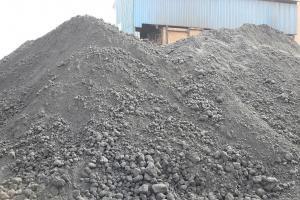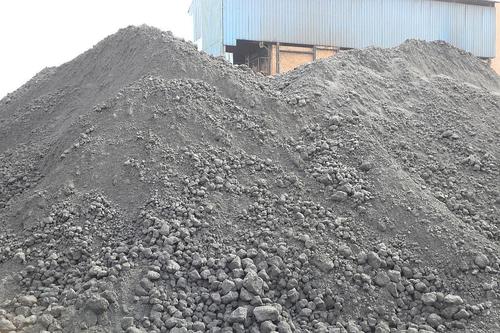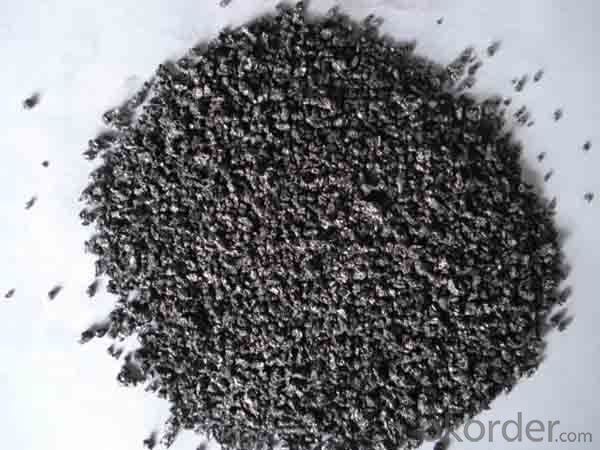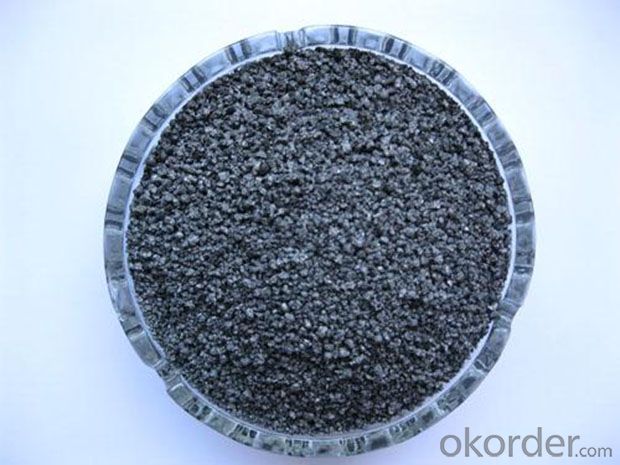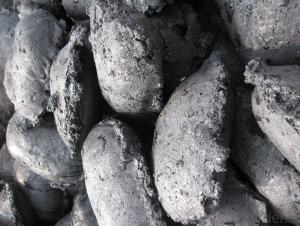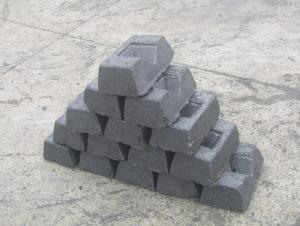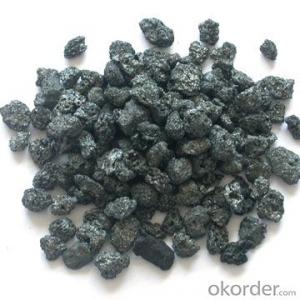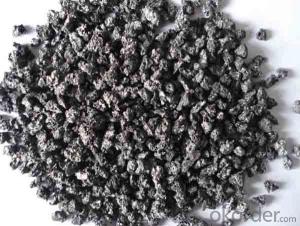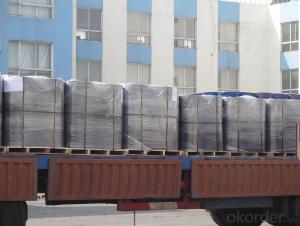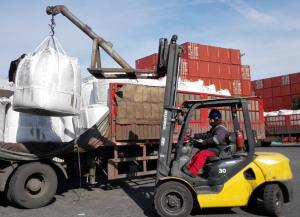Calcined Petroleum Coke/Carbon Raiser of CNBM in China
- Loading Port:
- Tianjin
- Payment Terms:
- TT OR LC
- Min Order Qty:
- 1 m.t.
- Supply Capability:
- 10000000 m.t./month
OKorder Service Pledge
OKorder Financial Service
You Might Also Like
1.Structure of Calcined Petroleum Coke Description
Calcined Petroleum Coke is made from raw petroleum coke,which is calcined in furnace at a high temperature(1200-1300℃).CPC/Calcined Petroleum Coke is widely used in steelmaking,castings manufacture and other metallurgical industry as a kind of recarburizer because of its high fixed carbon content,low sulfur content and high absorb rate.Besides,it is also a best kind of raw materials for producing artifical graphite(GPC/Graphitized Petroleum Coke) under the graphitizing temperature(2800℃).
2.Main Features of the Calcined Petroleum Coke
High-purity graphitized petroleum coke is made from high quality petroleum coke under a temperature of 2,500-3,500°C. As a high-purity carbon material, it has characteristics of high fixed carbon content, low sulfur, low ash, low porosity etc.It can be used as carbon raiser (Recarburizer) to produce high quality steel,cast iron and alloy.It can also be used in plastic and rubber as an additive.
3. Calcined Petroleum Coke Images
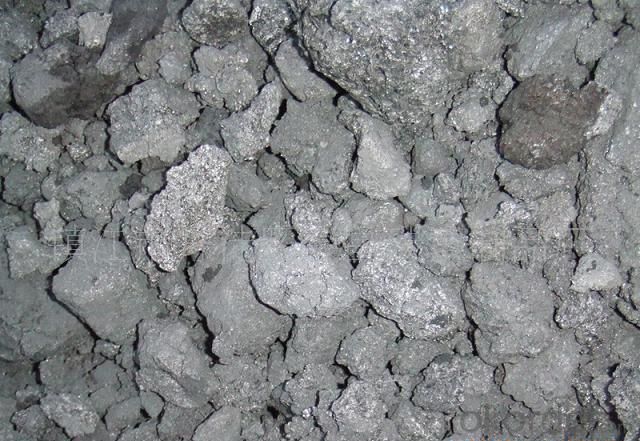
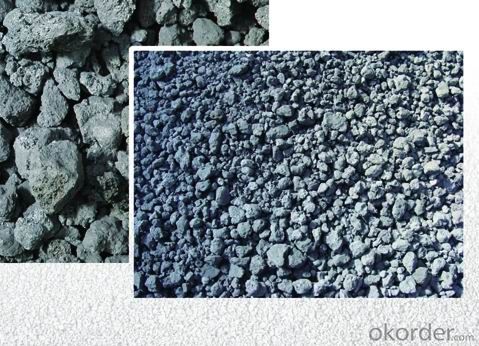
4. Calcined Petroleum Coke Specification
| Place of Origin: | China (Mainland) | Brand Name: | cnbm | Application: | Carrier Of Chemical Activator |
| Product Type: | Carbon Additive | C Content (%): | 91 | S Content (%): | 0.4 |
| Ash Content (%): | 5.5 | Volatile: | 1.5 | Size: | 1-5mm |
5.FAQ of Calcined Petroleum Coke
1). Q: Are you a factory or trading company?
A: We are a factory.
2). Q: Where is your factory located? How can I visit there?
A: Our factory is located in ShanXi, HeNan, China. You are warmly welcomed to visit us!
3). Q: How can I get some samples?
A: Please connect me for samples
4). Q: Can the price be cheaper?
A: Of course, you will be offered a good discount for big amount.
- Q: What is the carbon content of different fuels?
- The carbon content of different fuels varies depending on the source and composition of the fuel. Generally, fossil fuels such as coal, oil, and natural gas have high carbon content, with coal having the highest. Renewable fuels like biofuels and biomass also contain carbon, but their carbon content can vary depending on the feedstock and production process. On the other hand, carbon-neutral fuels like hydrogen and electricity have negligible carbon content, as they do not produce carbon dioxide when burned.
- Q: How are carbon fibers produced?
- Carbon fibers are produced through a multi-step process known as carbonization, where a polymer precursor material, usually made from polyacrylonitrile (PAN) or pitch, is heated and chemically treated to remove non-carbon elements. The resulting material is then subjected to high temperatures in an oxygen-free environment, transforming it into a carbon-rich fiber. This process creates strong, lightweight carbon fibers with excellent mechanical properties, making them ideal for various industrial applications.
- Q: What are the effects of carbon emissions on the stability of mangrove forests?
- Carbon emissions have significant effects on the stability of mangrove forests. Mangrove forests are highly vulnerable to changes in climate, and increased carbon emissions contribute to global warming and climate change, which directly impact these ecosystems. One of the main effects of carbon emissions on mangrove forests is rising sea levels. As carbon dioxide is released into the atmosphere, it traps heat and contributes to the warming of the planet. This leads to the melting of polar ice caps and glaciers, causing sea levels to rise. The increased sea levels pose a threat to mangroves as they are adapted to grow in intertidal zones, where they are exposed to both saltwater and freshwater. With rising sea levels, mangroves may experience increased inundation, which can lead to their submergence and eventual death. Furthermore, carbon emissions also contribute to ocean acidification. As carbon dioxide dissolves in seawater, it forms carbonic acid, which alters the pH balance of the ocean. Mangroves rely on the ocean for their nutrient supply and reproductive processes. Ocean acidification can impede the availability of essential nutrients, such as nitrogen and phosphorus, which are vital for the growth and survival of mangroves. Additionally, the acidification of seawater can negatively affect the reproduction and development of mangrove species, leading to a decline in their population. Carbon emissions also contribute to changes in weather patterns, such as increased frequency and intensity of storms and hurricanes. Mangroves act as a natural barrier, protecting coastal areas from the destructive impacts of these extreme weather events. However, with intensified storms and hurricanes, the stability of mangrove forests is compromised. Strong winds, heavy rainfall, and storm surges can uproot or damage mangrove trees, disrupting their structure and reducing their ability to provide coastal protection. Lastly, carbon emissions contribute to the overall warming of the planet, which can lead to changes in precipitation patterns. Mangroves rely on a delicate balance of freshwater and saltwater for their survival. Alterations in precipitation patterns, such as prolonged droughts or increased rainfall, can disrupt this balance and negatively impact mangroves. Droughts can lead to water scarcity, causing mangroves to become stressed and more susceptible to diseases and pests. On the other hand, increased rainfall can lead to excessive amounts of freshwater, diluting the salinity of mangrove habitats and affecting their growth and reproduction. In conclusion, carbon emissions have detrimental effects on the stability of mangrove forests. Rising sea levels, ocean acidification, changes in weather patterns, and alterations in precipitation patterns all contribute to the degradation and loss of mangrove ecosystems. It is crucial to reduce carbon emissions and mitigate the effects of climate change to ensure the long-term survival and stability of mangrove forests.
- Q: What is carbon black pigment?
- Carbon black pigment is a fine black powder derived from the incomplete combustion of hydrocarbons. It is primarily composed of elemental carbon and is widely used as a pigment in various industries, including rubber, plastics, inks, coatings, and cosmetics, to impart a deep black color and enhance the strength and durability of the materials it is incorporated into.
- Q: Emerald garden high carbon tempered metal
- The middle gate's most advanced war puppet! 3 o'clock, 9 o'clock position.Black dealers are also available
- Q: What are the effects of carbon emissions on animal populations?
- Carbon emissions have profound effects on animal populations. One of the main consequences is the disruption of ecosystems and the loss of habitats. As carbon dioxide levels rise in the atmosphere, the Earth's temperature increases, leading to climate change. This change in climate can alter the availability of resources such as food and water, making it more difficult for animals to survive and reproduce. Additionally, carbon emissions contribute to ocean acidification. When carbon dioxide is absorbed by seawater, it reacts with water to form carbonic acid, which lowers the pH of the ocean. This acidification has detrimental effects on marine life, especially on species that rely on calcium carbonate to build their shells or skeletons, such as corals and shellfish. As their habitats become more corrosive, these animals struggle to survive and reproduce, leading to significant declines in their populations. Furthermore, carbon emissions are often associated with air pollution, which has direct and indirect impacts on animal populations. High levels of air pollution, specifically from pollutants like nitrogen dioxide and particulate matter, can cause respiratory problems and other health issues in animals. This can lead to reduced fitness and increased mortality rates, ultimately affecting the overall population size. Lastly, carbon emissions contribute to deforestation and habitat destruction. As more land is cleared for human activities like agriculture or urbanization, animal populations lose their natural habitats and are forced to adapt to fragmented landscapes. This fragmentation restricts their movement, limits access to resources, and increases their vulnerability to predation and other threats. In conclusion, carbon emissions have far-reaching effects on animal populations, including habitat loss, climate change, ocean acidification, air pollution, and deforestation. These impacts disrupt ecosystems and threaten the survival of many animal species. It is crucial to address carbon emissions and reduce our carbon footprint to mitigate these detrimental effects and protect the diversity of life on Earth.
- Q: What are the meanings of carbon, graphite, burr, two cuts and four cuts in steel?.
- Flash is to flash, or two bending. Two cuts; one cut two on average, three segments, four cuts; an average cut of four, and five segments. The back is industry talk.
- Q: How does carbon impact the migration patterns of animals?
- Carbon emissions from human activities contribute to climate change, which in turn affects the migration patterns of animals. Rising temperatures, altered precipitation patterns, and changing habitats disrupt the availability of food, water, and suitable nesting or breeding grounds for many species. As a result, some animals may alter their migration routes, timing, or destinations, while others may struggle to adapt and face population declines or even extinction. The impact of carbon on animal migration underscores the urgent need to mitigate greenhouse gas emissions and protect the ecosystems that support these vital movements.
- Q: What are the uses of carbon black?
- Carbon black is primarily used as a reinforcing filler in tires and other rubber products to improve their durability and strength. Additionally, it is widely employed as a pigment in inks, coatings, and plastics due to its ability to provide color and UV protection. Carbon black also finds applications in batteries, electrodes, conductive materials, and as a catalyst support in chemical reactions.
- Q: How is carbon used in the production of activated carbon filters?
- Various industries and applications widely utilize activated carbon filters. These filters are utilized in water and air purification, gas masks, and even in the production of certain chemicals. The effectiveness of activated carbon filters heavily relies on the role of carbon in their production. Activated carbon, also referred to as activated charcoal, is a type of carbon that possesses a highly porous structure and a large surface area. The creation of this porous structure is achieved through a process known as activation. Activation involves subjecting carbonaceous materials, such as coal, wood, or coconut shells, to high temperatures in the presence of steam or specific chemicals. This activation process generates tiny pores and significantly increases the carbon's surface area. Consequently, the carbon becomes adept at capturing and eliminating impurities from gases or liquids. The activated carbon's high adsorption capacity attracts impurities like organic compounds, volatile organic compounds (VOCs), and certain heavy metals to its surface. In the production of activated carbon filters, the activated carbon is commonly molded into a granular or powdered state and then packed into a filter medium, such as a mesh or a cartridge. The filter medium functions as a supportive structure for the activated carbon, enabling the passage of air or water while effectively capturing and adsorbing impurities. Activated carbon filters excel at eliminating a wide array of contaminants, including chlorine, volatile organic compounds (VOCs), odors, and specific heavy metals. Consequently, these filters greatly enhance the quality of water and air by reducing pollutants and improving odor control. Furthermore, the versatility of activated carbon allows for customization based on the specific application. For instance, activated carbon can be infused with specific chemicals to heighten its adsorption capacity for particular contaminants. It can also be specially treated to target pollutants like mercury or arsenic. In conclusion, the utilization of carbon in the production of activated carbon filters stems from its porous structure and exceptional adsorption properties. These filters play a vital role in numerous industries and applications, effectively eliminating impurities from water and air, improving their quality, and ultimately benefiting environmental and human health.
Send your message to us
Calcined Petroleum Coke/Carbon Raiser of CNBM in China
- Loading Port:
- Tianjin
- Payment Terms:
- TT OR LC
- Min Order Qty:
- 1 m.t.
- Supply Capability:
- 10000000 m.t./month
OKorder Service Pledge
OKorder Financial Service
Similar products
Hot products
Hot Searches
Related keywords
